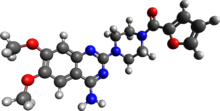Prazosin
 | |
 | |
| Clinical data | |
|---|---|
| Trade names | Minipress, others |
| AHFS/Drugs.com | Monograph |
| MedlinePlus | a682245 |
| License data | |
| Pregnancy category |
|
| Routes of administration | By mouth |
| Drug class | α1 blocker |
| ATC code | |
| Legal status | |
| Legal status | |
| Pharmacokinetic data | |
| Bioavailability | ~60% |
| Protein binding | 97%[4] |
| Onset of action | 30–90 minutes[5] |
| Elimination half-life | 2–3 hours[4] |
| Duration of action | 10–24 hours[4] |
| Identifiers | |
| |
JSmol) | |
| |
| |
| (verify) | |
Prazosin, sold under the brand name Minipress among others, is a
Common
Prazosin was patented in 1965 and came into medical use in 1974.
Medical uses
Prazosin is active after taken by mouth and has a minimal effect on cardiac function due to its
The antihypertensive characteristics of prazosin make it a second-line choice for the treatment of high blood pressure.[11]
Prazosin is also useful in treating urinary hesitancy associated with benign prostatic hyperplasia, blocking α1-adrenergic receptors, which control constriction of both the prostate and urethra. Although not a first-line choice for either hypertension or benign prostatic hyperplasia, it is a choice for people who present with both problems concomitantly.[11]
During its use for urinary hesitancy in military veterans in the 1990s, Murray A. Raskind and colleagues discovered that prazosin appeared to be effective in reducing nightmares. Subsequent reviews indicate prazosin is effective in improving sleep quality and treating nightmares related to post-traumatic stress disorder (PTSD).[12][13]
Prazosin is used off-label in the treatment of insomnia and can produce sedative effects.[14][15]
The drug is usually recommended for severe stings from the
Adverse effects
Common (4–10% frequency) side effects of prazosin include
Orthostatic hypotension and syncope are associated with the body's poor ability to control blood pressure without active α-adrenergic receptors. The nasal congestion is exacerbated by changing body positions, because α1-adrenergic receptors also control nasal vascular blood flow and alpha blockers inhibit this, in the same way that alpha-adrenergic agonists have the opposite effect of being a decongestant.[20][21]
Pharmacology
Pharmacodynamics
Prazosin is an
Pharmacokinetics
Prazosin has an
Research
Prazosin has been said to be the only selective α1-adrenergic receptor antagonist which has been used in the treatment of insomnia to any significant degree.[14] It is used at doses of 1 to 12 mg for this purpose.[14] The combination of prazosin and the beta blocker timolol may produce greater sedative effects than either of them alone.[15]
Prazosin has been shown to prevent death in animal models of
References
- ^ "Prazosin (Minipress) Use During Pregnancy". Drugs.com. 26 November 2019. Retrieved 30 January 2020.
- ^ "Hypovase Tablets 0.5mg - Summary of Product Characteristics (SmPC)". (emc). 26 April 2021. Retrieved 5 February 2023.
- ^ a b c d e "Minipress- prazosin hydrochloride capsule". DailyMed. 19 July 2021. Retrieved 5 February 2023.
- ^ a b c d e "Prazosin". drugs.com. Retrieved 15 March 2020.
- ^ PMID 761333.
- ^ a b c d e f g h i j "Prazosin Hydrochloride Monograph for Professionals". Drugs.com. American Society of Health-System Pharmacists. Retrieved 18 March 2019.
- ^ ISBN 9780857113382.
- ISBN 9783527607495.
- ^ "The Top 300 of 2021". ClinCalc. Archived from the original on 15 January 2024. Retrieved 14 January 2024.
- ^ "Prazosin - Drug Usage Statistics". ClinCalc. Retrieved 14 January 2024.
- ^ ISBN 978-1-59541-101-3.
- PMID 31972510.
- S2CID 218492349.
- ^ PMID 26600112.
- ^ S2CID 3578916.
- JSTOR 24103245.
- PMID 17444339.
- S2CID 37215729.
- PMID 519276.
- S2CID 24405406.
- S2CID 70981730.
- ^ "Prazosin: Biological activity". IUPHAR. International Union of Basic and Clinical Pharmacology. Retrieved 3 June 2016.
- ^ a b "Prazosin". DrugBank.
- ^ a b "Prazosin Ligand page". IUPHAR/BPS Guide to PHARMACOLOGY.
- ^ "Prazosin: Clinical data". IUPHAR. International Union of Basic and Clinical Pharmacology. Retrieved 3 June 2016.
This sympatholytic drug is used in the treatment of hypertension, anxiety and post-traumatic stress disorder. ... Antagonist of alpha-1 adrenoceptors on vascular smooth muscle, thereby inhibiting the vasoconstrictor effect of circulating and locally-released adrenaline and noradrenaline, resulting in peripheral vasodilation.
- S2CID 28007564.
- S2CID 53151786.
- ^ PMID 32352407.
- PMID 30542164.
- ^ "Preventing 'Cytokine Storm' May Ease Severe COVID-19 Symptoms". HHMI.org. Retrieved 24 May 2020.
- ^ Clinical trial number NCT04365257 for "Prazosin to Prevent COVID-19 (PREVENT-COVID Trial) (PREVENT)" at ClinicalTrials.gov
